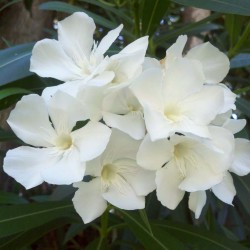Menu
-
MenuZpět
- Home
-
Kategorie
-
-
Kategorie
-
Zeleninová semínka
-
Odrůdy podle země
- Odrůdy z Arménie
- Odrůdy od BiH
- Odrůdy z Chorvatska
- Odrůdy z Francie
- Odrůdy z Německa
- Varieties from Greece
- Varieties from Hungary
- Odrůdy z Indie
- Varieties from Italy
- Odrůdy z Japonska
- Odrůdy ze Severní Makedonie
- Varieties from Peru
- Varieties from Russia
- Varieties from Serbia
- Odrůdy ze Slovinska
- Varieties from Spain
- Varieties from Thailand
- Odrůdy z Turecka
- Varieties from USA
- Semena rajčat
- Semena kukuřice
- Tykev rodina
- Rodina fazole
- Semena okurky
- Semena papriky
- Rodina mrkve
- Cibulová rodina
- Salátová semínka
- Rodina brambor
- Rodina zelí
- Semena ředkvičky
- Rodina z červené řepy
- Semena melounu
- Melounová semínka
- Semena květáku
- Slunečnicová rodina
-
Odrůdy podle země
- Ovocná semínka
- Chili semínka
- Semena léčivých bylin
- Semena horolezeckých rostlin
- Stromy - keř - semena
- Palmová semínka
- Semena okrasných trav
- Semena tabáku
-
Zeleninová semínka
-
-
-
-
- NOVÉ PRODUKTY
- Dodání - platba
- Vytvořit účet
- FAQ
Last Product Reviews
Out of the two seeds, one germinated and the other one was dead and floatin...
By
 Riikka H on 07/03/2024
Riikka H on 07/03/2024
Verified Purchase
Počet produktů: 170
Seřadit podle:
Zobrazení 151-165 z 170 položek

Rostlina odolná vůči mrazu a mrazu

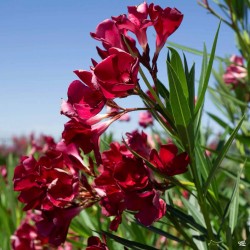
Semena Červené Oleandr...
Cena
1,95 €
(SKU: T 62 R)
Seeds Gallery EU,
5/
5
<!DOCTYPE html>
<html>
<head>
<meta http-equiv="Content-Type" content="text/html; charset=UTF-8" />
</head>
<body>
<h2><strong>Semena Červené Oleandr obecný (Nerium oleander)</strong></h2>
<h2><span style="color: #ff0000;"><strong>Cena za balení 10 semen.</strong></span></h2>
<p>Sestra Agnes nebo Soeur Agnes má upřímný bílý květ o průměru asi 6 cm a kvete od června do září a hrdlo květů je krémově zbarvené</p>
<p>Vidíme, jak exploduje v celé své kráse na terasách, zahradách, parcích a dává každé oblasti královský, starověký, romantický aspekt</p>
<p>Je to oleandr , vědecký název Nerium oleander , vždyzelený keř, který je všestranný a velmi krásný. Při pravidelném stříhání si zachovává malé rozměry a zřídka přesahuje jeden a půl metru nebo dva metry na výšku.</p>
<p>V zahradách může v průběhu času dosáhnout značné velikosti a v mírných klimatických oblastech se stát skutečným stromem.</p>
<p>Oleander je italská rostlina rozšířená v polospontánním stavu po celém středním jihu, která do Středomoří dorazila v odlehlých dobách, pravděpodobně ze Středního východu. Již v roce 300 nl o ní Theophrastus v pojednání o rostlinách hovořil :. již tehdy používán jako okrasná rostlina.</p>
<p>Oleandr je rod, který zahrnuje tři druhy vždyzelených keřů nebo malých stromů, s lineárními, úzkými, kopinatými, celými, tmavě zelenými listy. Květy, které se liší od růžové po bílou, červenou až žlutou, mohou být jednoduché nebo dvojité. Produkuje nápadné, červenohnědé plody, vzpřímené, dlouhé 10 až 15 cm, obsahující některá semena.</p>
<p>Oleandr, Nerium oleander, je velmi odolný vždyzelený keř, a proto se masivně pěstuje v městském prostředí. Má vynikající odolnost vůči slanosti a suchu: je to rostlina pěstovaná pro okrasné účely a pro jednoduché pěstování.</p>
<p><strong>Botanická klasifikace</strong></p>
<p>Oleandr (Nerium oleander) je vždyzelený keř patřící do čeledi Apocynaceae, jediný druh rodu Nerium. Pravděpodobně pochází z Asie, ale ve středomořských oblastech je naturalizovaný a spontánní.</p>
</body>
</html>
T 62 R


Rostlina odolná vůči mrazu a mrazu
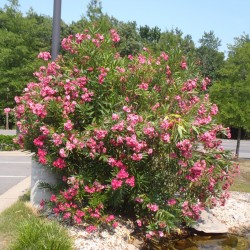
Rose Bay - Rose Laurel...
Cena
1,95 €
(SKU: T 62)
Seeds Gallery EU,
5/
5
<!DOCTYPE html>
<html>
<head>
<meta http-equiv="Content-Type" content="text/html; charset=UTF-8" />
</head>
<body>
<h2><span style="font-size: 14pt;"><strong>Rose Bay - Rose Laurel Seeds (Nerium oleander)</strong></span></h2>
<h2><span style="color: #ff0000; font-size: 14pt;"><strong>Price for Package of 10 seeds.</strong></span></h2>
<p>Undoubtedly a candidate for most poisonous plant in the garden but also a contender for most beautiful.</p>
<p>This species is considered to be native to Spain, the Balearic Islands and Morocco east through Mediterranean coastal countries to the Arabian Peninsula, Ethiopia, Niger, Afghanistan, Iran and Iraq to India and central China. It occurs as a non-native in parts of Africa, the Azores, Japan, Indonesia, Australia, New Zealand, the United States, central and eastern Mexico, Central and South America.</p>
<p>This species is very widely cultivated as an ornamental. All parts of the plant are poisonous and so it is not grazed or eaten. Steam from boiled leaves is inhaled to relieve sinusitis, pounded leaves are applied to the skin to relieve itching, ulcers and tumours (Jongbloed 2003); the leaves are used as an insecticide.</p>
<p>Nerium</p>
<p>Believed to come from the Greek ‘nerion’ which is, itself, believed to be based on ‘neros’, ‘wet’ or ‘fresh’.</p>
<p>oleander</p>
<p>Possibly a combination of the Latin ‘olea’, ‘olive’ and ‘rodandrum’, ‘rhododendron’ meaning the plant looks somewhat similar to a cross between these two.</p>
<p>Common Names and Synonyms</p>
<p>oleander, rose bay, common oleander, rose laurel</p>
<h2>WIKIPEDIA:</h2>
<p>Nerium oleander /ˈnɪəriəm ˈoʊliː.ændər/[3] is an evergreen shrub or small tree in the dogbane family Apocynaceae, toxic in all its parts. It is the only species currently classified in the genus Nerium. It is most commonly known as oleander, from its superficial resemblance to the unrelated olive Olea.[Note 1] It is so widely cultivated that no precise region of origin has been identified, though southwest Asia has been suggested. The ancient city of Volubilis in Morocco may have taken its name from the Berber name oualilt for the flower.[4] Oleander is one of the most poisonous commonly grown garden plants.</p>
<p><strong>Description</strong></p>
<p>Oleander grows to 2–6 m (6.6–19.7 ft) tall, with erect stems that splay outward as they mature; first-year stems have a glaucous bloom, while mature stems have a grayish bark. The leaves are in pairs or whorls of three, thick and leathery, dark-green, narrow lanceolate, 5–21 cm (2.0–8.3 in) long and 1–3.5 cm (0.39–1.38 in) broad, and with an entire margin. The flowers grow in clusters at the end of each branch; they are white, pink to red,[Note 2] 2.5–5 cm (0.98–1.97 in) diameter, with a deeply 5-lobed fringed corolla round the central corolla tube. They are often, but not always, sweet-scented.[Note 3] The fruit is a long narrow capsule 5–23 cm (2.0–9.1 in) long, which splits open at maturity to release numerous downy seeds.</p>
<p><strong>Habitat and range</strong></p>
<p>N. oleander is either native or naturalized to a broad area from Mauritania, Morocco, and Portugal eastward through the Mediterranean region and the Sahara (where it is only found sporadically), to the Arabian peninsula, southern Asia, and as far East as Yunnan in southern parts of China.[5][6][7][8] It typically occurs around dry stream beds. Nerium oleander is planted in many subtropical and tropical areas of the world. On the East Coast of the US, it grows as far north as Virginia Beach, Virginia, while in California and Texas it is naturalized as a median strip planting.[citation needed] Because of its durability, Oleander was planted prolifically on Galveston Island in Texas after the disastrous Hurricane of 1900. They are so prolific that Galveston is known as the 'Oleander City'; an annual Oleander festival is hosted every spring.[9] Oleander can be grown successfully outdoors in southern England, particularly in London and mild coastal regions of Dorset and Cornwall.</p>
<p><strong>Ecology</strong></p>
<p>Some invertebrates are known to be unaffected by oleander toxins, and feed on the plants. Caterpillars of the polka-dot wasp moth (Syntomeida epilais) feed specifically on oleanders and survive by eating only the pulp surrounding the leaf-veins, avoiding the fibers. Larvae of the common crow butterfly (Euploea core) also feed on oleanders, and they retain or modify toxins, making them unpalatable to would-be predators such as birds, but not to other invertebrates such as spiders and wasps.</p>
<p>The flowers require insect visits to set seed, and seem to be pollinated through a deception mechanism. The showy corolla acts as a potent advertisement to attract pollinators from a distance, but the flowers are nectarless and offer no reward to their visitors. They therefore receive very few visits, as typical of many rewardless flower species.[11][12] Fears of honey contamination with toxic oleander nectar are therefore unsubstantiated.</p>
<p><strong>Ornamental gardening</strong></p>
<p>Oleander is a vigorous grower in warm subtropical regions, where it is extensively used as an ornamental plant in parks, along roadsides, and as a windbreak. It will tolerate occasional light frost down to −10 °C (14 °F).,[8] though the leaves may be damaged. The toxicity of Oleander renders it deer-resistant. The plant is tolerant of poor soils, salt spray, and sustained drought, although it will flower and grow more vigorously with regular water. Nerium Oleander also responds well to heavy pruning, which should be done in the autumn or early spring to keep plants from becoming unruly.</p>
<p>In cold-winter climates Oleander can be grown in greenhouses and conservatories, or as potted indoor plants that can be kept outside in the summer. Oleander flowers are showy, profuse, and often fragrant, which makes them very attractive in many contexts. Over 400 cultivars have been named, with several additional flower colors not found in wild plants having been selected, including red, pink, yellow, and salmon; white and a variety of pinks are the most common. Double flowered cultivars like 'Mrs Isadore Dyer' or 'Mont Blanc' are enjoyed for their large, rose-like blooms and strong fragrance. Many dwarf cultivars have also been developed, which grow only to about 10' at maturity. In most Mediterranean climates they can be expected to bloom from April through October, with their heaviest bloom usually in May or June.</p>
<p><strong>Toxicity</strong></p>
<p>Oleander has historically been considered a poisonous plant because some of its compounds may exhibit toxicity, especially to animals, when consumed in large amounts. Among these compounds are oleandrin and oleandrigenin, known as cardiac glycosides, which are known to have a narrow therapeutic index and can be toxic when ingested.</p>
<p>Toxicity studies of animals administered oleander extract concluded that rodents and birds were observed to be relatively insensitive to oleander cardiac glycosides.[16] Other mammals, however, such as dogs and humans, are relatively sensitive to the effects of cardiac glycosides and the clinical manifestations of "glycoside intoxication".</p>
<p>However, despite the common "poisonous" designation of this plant, very few toxic events in humans have been reported. According to the Toxic Exposure Surveillance System, in 2002, 847 human exposures to oleander were reported to poison centers in the United States.[19] Despite this exposure level, from 1985 through 2005, only three deaths were reported. One cited death was apparently due to the ingestion of oleander leaves by a diabetic man.[20] His blood indicated a total blood concentration of cardiac glycosides of about 20 μg/l, which is well above the reported fatal level. Another study reported on the death of a woman who self-administered "an undefined oleander extract" both orally and rectally and her oleandrin tissue levels were 10 to 39 μg/g, which were in the high range of reported levels at autopsy.[21] And finally, one study reported the death of a woman who ingested oleander 'tea'.[22] Few other details were provided.</p>
<p>In contrast to consumption of these undefined oleander-derived materials, no toxicity or deaths were reported from topical administration or contact with N. oleander or specific products derived from them. In reviewing oleander toxicity, Lanford and Boor[23] concluded that, except for children who might be at greater risk, "the human mortality associated with oleander ingestion is generally very low, even in cases of moderate intentional consumption (suicide attempts)".</p>
<p>Toxicity studies conducted in dogs and rodents administered oleander extracts by intramuscular injection indicated that, on an equivalent weight basis, doses of an oleander extract with glycosides 10 times those likely to be administered therapeutically to humans are still safe and without any "severe toxicity observed".</p>
<p>In South Indian states such as Tamil Nadu and in Sri Lanka the seeds of related plant with similar local name (Kaneru(S) කණේරු) Cascabela thevetia produce a poisonous plum with big seeds. As these seeds contain cardenolides, swallowing them is one of the preferred methods for suicides in villages.</p>
<p><strong>Effects of poisoning</strong></p>
<p>Ingestion of this plant can affect the gastrointestinal system, the heart, and the central nervous system. The gastrointestinal effects can consist of nausea and vomiting, excess salivation, abdominal pain, diarrhea that may contain blood, and especially in horses, colic.[7] Cardiac reactions consist of irregular heart rate, sometimes characterized by a racing heart at first that then slows to below normal further along in the reaction. Extremities may become pale and cold due to poor or irregular circulation. The effect on the central nervous system may show itself in symptoms such as drowsiness, tremors or shaking of the muscles, seizures, collapse, and even coma that can lead to death.</p>
<p>Oleander sap can cause skin irritations, severe eye inflammation and irritation, and allergic reactions characterized by dermatitis.</p>
<p><strong>Treatment</strong></p>
<p>Poisoning and reactions to oleander plants are evident quickly, requiring immediate medical care in suspected or known poisonings of both humans and animals.[25] Induced vomiting and gastric lavage are protective measures to reduce absorption of the toxic compounds. Charcoal may also be administered to help absorb any remaining toxins.[7] Further medical attention may be required depending on the severity of the poisoning and symptoms. Temporary cardiac pacing will be required in many cases (usually for a few days) until the toxin is excreted.</p>
<p>Digoxin immune fab is the best way to cure an oleander poisoning if inducing vomiting has no or minimal success, although it is usually used only for life-threatening conditions due to side effects.</p>
<p>Drying of plant materials does not eliminate the toxins. It is also hazardous for animals such as sheep, horses, cattle, and other grazing animals, with as little as 100 g being enough to kill an adult horse.[26] Plant clippings are especially dangerous to horses, as they are sweet. In July 2009, several horses were poisoned in this manner from the leaves of the plant.[27] Symptoms of a poisoned horse include severe diarrhea and abnormal heartbeat. There is a wide range of toxins and secondary compounds within oleander, and care should be taken around this plant due to its toxic nature. Different names for oleander are used around the world in different locations, so, when encountering a plant with this appearance, regardless of the name used for it, one should exercise great care and caution to avoid ingestion of any part of the plant, including its sap and dried leaves or twigs. The dried or fresh branches should not be used for spearing food, for preparing a cooking fire, or as a food skewer. Many of the oleander relatives, such as the desert rose (Adenium obesum) found in East Africa, have similar leaves and flowers and are equally toxic.</p>
<p><strong>Folklore</strong></p>
<p>The alleged toxicity of the plant makes it the center of an urban legend documented on several continents and over more than a century. Often told as a true and local event, typically an entire family, or in other tellings a group of scouts, succumbs after consuming hot dogs or other food roasted over a campfire using oleander sticks.</p>
<p><strong>Garden history</strong></p>
<p>In his book Enquiries into Plants of circa 300 BC, Theophrastus described (among plants that affect the mind) a shrub he called onotheras, which modern editors render oleander; "the root of onotheras [oleander] administered in wine", he alleges, "makes the temper gentler and more cheerful".</p>
<p>The plant has a leaf like that of the almond, but smaller, and the flower is red like a rose. The plant itself (which loves hilly country) forms a large bush; the root is red and large, and, if this is dried, it gives off a fragrance like wine.</p>
<p>In another mention, of "wild bay" (Daphne agria), Theophrastus appears to intend the same shrub.</p>
<p>Oleander was a very popular ornamental shrub in Roman peristyle gardens; it is one of the flora most frequently depicted on murals in Pompeii and elsewhere in Italy. These murals include the famous garden scene from the House of Livia at Prima Porta outside Rome, and those from the House of the Wedding of Alexander and the Marine Venus in Pompeii.</p>
<p>Willa Cather, in her book The Song of the Lark, mentions oleander in this passage:</p>
<p>This morning Thea saw to her delight that the two oleander trees, one white and one red, had been brought up from their winter quarters in the cellar. There is hardly a German family in the most arid parts of Utah, New Mexico, Arizona, but has its oleander trees. However loutish the American-born sons of the family may be, there was never one who refused to give his muscle to the back-breaking task of getting those tubbed trees down into the cellar in the fall and up into the sunlight in the spring. They may strive to avert the day, but they grapple with the tub at last.</p>
<p>Oleander is the official flower of the city of Hiroshima, having been the first to bloom following the atomic bombing of the city in 1945.</p>
<p>It is the provincial flower of Sindh province.</p>
</body>
</html>
T 62 P

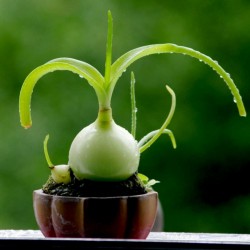
Semena Snědek ocasatý...
Cena
3,80 €
(SKU: CT 23)
Seeds Gallery EU,
5/
5
<meta http-equiv="Content-Type" content="text/html; charset=UTF-8" />
<h2><strong>Semena Snědek ocasatý (Albuca bracteata)</strong></h2>
<h2><strong><span style="color: #ff0000;">Cena za balení 3 semen.</span> </strong></h2>
<p><b>Snědek ocasatý</b><span> </span>(<i>Albuca bracteata</i>, syn.<span> </span><i>Ornithogalum longebracteatum</i>) je cibulnatá rostlina z<span> </span>čeledi<span> </span>chřestovité<span> </span>pocházející z<span> </span>Jižní Afriky. Velká cibule jí umožňuje přežít v době sucha klasického<span> </span>mediterátního<span> </span>klimatu této oblasti.<sup id="cite_ref-cactus_1-0" class="reference"></sup></p>
<h2><span class="mw-headline" id="Cibule">Cibule</span></h2>
<p>Cibule může dosáhnout v průměru až 10 centimetrů a její povrch je voskově zelený a převážně hladký s odumřelými částmi cibule, které se odlupují. Vytváří ve svém okolí velké množství malých dceřiných cibulek.<sup id="cite_ref-cactus_1-1" class="reference"></sup></p>
<h2><span class="mw-headline" id="Listy">Listy</span></h2>
<p>Z cibule vyrůstají dlouhé zelené šťavnaté pruhovité listy, které při dobrých podmínkách mohou mít až metr.<sup id="cite_ref-cactus_1-2" class="reference"></sup></p>
<h2><span id="Kv.C4.9Bty"></span><span class="mw-headline" id="Květy">Květy</span></h2>
<p>Vytváří klasovité květenství o velikosti 70 až 90 cm s velkým množstvím (50 až 100 kvítků) vonných bílých květů se zelenkavým středem. Nejčastěji kvete od května do srpna.<sup id="cite_ref-cactus_1-3" class="reference"></sup></p>
<h2><span id="P.C4.9Bstov.C3.A1n.C3.AD"></span><span class="mw-headline" id="Pěstování">Pěstování</span></h2>
<p>Rostliny jsou velice přizpůsobivé a tím i velice vhodné pro pěstování v nádobách. Upřednostňuje především přímé letní slunce. Substrát by měl být dobře propustný. Nejlépe se osvědčila kaktusová zem s rašelinou, která dokáže dobře zadržet vodu. V případě, že rostlina nebude déle zalévána, dojde k úhynu listů a rostlina se zatáhne do cibule, kdy pro ní dochází k zimnímu spánku. Rostliny vydrží teploty maximálně k -5 °C.</p>
<h2><span class="mw-headline" id="Množení">Množení</span></h2>
<p>Rostlinu můžeme množit pomocí dceřiných cibulí, které vytváří okolo hlavní cibule, ale i na ní (odtud anglický název těhotná cibule). Také je možno rostlinu množit semeny, které vysejeme do dobře propustného substrátu. Měly by vyklíčit během jednoho měsíce.<sup id="cite_ref-cactus_1-5" class="reference"></sup></p>
<h2><span id="Vyu.C5.BEit.C3.AD"></span><span class="mw-headline" id="Využití">Využití</span></h2>
<p>Ve své domovině jsou rozdrcené listy často používány na řezné rány a pohmožděniny. Podle některých zdrojů má podobné léčivé účinky jako například aloe vera. Také se její listy vařené v cukernatém roztoku využívají jako sirup proti nachlazení.</p>
CT 23 (3 S)


Obří rostlina (s obřími plody)
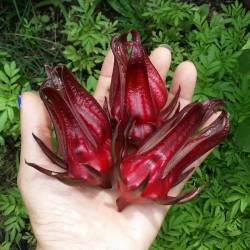
Semena obří Ibišek Súdánský...
Cena
3,50 €
(SKU: MHS 19 G)
Seeds Gallery EU,
5/
5
<div>
<h2 class=""><strong>Semena obří Ibišek Súdánský (Hibiscus sabdariffa)</strong></h2>
<h2><span style="color: #ff0000;" class=""><strong>Cena za balení 5 semen.</strong></span></h2>
</div>
<p><strong><span style="color: #000000; font-size: 18px;">Plody této Ibišek Súdánský jsou dvakrát větší než jakékoli jiné roselle.</span></strong><br>Ibišek súdánský je jednoletá bylina, která dorůstá do výšky 1 – 2 m. Její původ sahá zřejmě do oblasti západní Afriky. V současné době se jedná o rostlinu s oblibou pěstovanou téměř ve všech tropických oblastech.<br><br>Tento druh ibišku je charakteristický svými dužnatými kalichy, červené barvy. Ty se využívají jako potravina či léčivo.<br><br>Ibišek súdánský je znám vysokým obsahem zdraví prospěšných látek – vitamínu C, flavonoidů, karotenů, mastných kyselin ad. Používá se zejména jako silný antioxidant či jako pomocník při regeneraci buněk.<br><br>Semena tohoto ibišku se vysévají od února do března. Před výsevem je namočte na 24 hodin do vlažné vody. Hloubka výsevu je 0,5 cm. Doba klíčení je 2 – 4 týdny při teplotě 20 – 25 °C.<br><br>Pro dobrý růst potřebuje ibišek dostatek světla, tepla a výživnou půdu. Ta by měla být dostatečně propustná s dobrou drenáží.<br><br>Ibišek lze pěstovat doma jako pokojovou rostlinu nebo ve vytápěném skleníku či zimní zahradě. Teplota by nikdy neměla klesnout pod 15 °C.<br><br>Rostlinu pravidelně zalévejte tak, aby nedošlo k jejímu přemokření. Ibišek vyžaduje také pravidelné hnojení. </p>
MHS 19 G (5 S)


Rostlina odolná vůči mrazu a mrazu
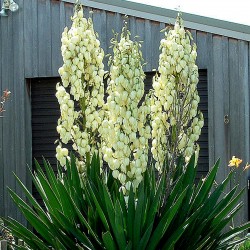
Semena Juka vláknitá (Yucca...
Cena
2,35 €
(SKU: CT 8)
Seeds Gallery EU,
5/
5
<h2 class=""><strong>Semena Juka vláknitá (Yucca filamentosa)</strong></h2>
<h2><span style="color: #ff0000;"><strong>Cena za balení 5 semen.</strong></span></h2>
<b style="color: #202122; font-size: 14px;">Juka vláknitá</b><span style="color: #202122; font-size: 14px;"><span> </span>(</span><i style="color: #202122; font-size: 14px;">Yucca filamentosa</i><span style="color: #202122; font-size: 14px;">) je<span> </span></span>druh<span style="color: #202122; font-size: 14px;"><span> </span>rostlin, bylin z<span> </span></span>čeledi<span style="color: #202122; font-size: 14px;"><span> </span></span>chřestovité<span style="color: #202122; font-size: 14px;"><span> </span>(</span><i style="color: #202122; font-size: 14px;">Asparagaceae</i><span style="color: #202122; font-size: 14px;">). Původní výskyt druhu je znám z jihovýchodu USA. V České republice je juka vláknitá pěstována jako<span> </span></span>okrasná rostlina<span style="color: #202122; font-size: 14px;">.</span><br />Obvykle bez kmene je to multisuckering s hlavami 75 cm (30 palců) dlouhými, vláknitými, modrozelenými, strapatými listy. Y. filamentosa se snadno odlišuje od ostatních druhů yucky bílými vlákny podél okrajů listů. Na začátku léta květní stonky až 3 m vysoké medvědí masy převislých krémových květů. Jsou opylovány yuckou můrou Tegeticula yuccasella. Jiné druhy můr, jako je Tegeticula intermedia, také používají tuto juku jako hostitelskou rostlinu pro kladení vajíček.<br /><br />Použití<br /><br />Jakmile jsou semena odstraněna, mohou být plody vařeny a konzumovány. Velké okvětní lístky lze také jíst v salátech.<br /><br />Listy, stonky a kořeny této rostliny lze použít k omráčení ryb. Cherokee to použil k tomuto účelu.
CT 8 (5 S)


Tento produkt nelze platit kartou PayPal ani kartou

Shirley Poppy Seeds Mixed...
Cena
1,95 €
(SKU: MHS 43)
Seeds Gallery EU,
5/
5
<div id="idTab1" class="rte">
<h2><strong>Shirley Poppy Seeds Mixed Colors, Decorative, Ornamental</strong></h2>
<h2><span style="color: #ff0202;"><strong>Price for a Package of 200 seeds.</strong></span></h2>
<p>Shirley Poppy (Papaver Rhoeas) - The Shirley Poppy comes from Shirley, England, where in the 1880s, a local vicar carefully selected and hybridized Poppies in his own wild flower garden. Over many years he obtained a strain of Poppies ranging in colors from white to pale lilac to pink and red, and unlike the wild Poppies these had no dark blotches at the base of the petals. Over the years, further wildflower Poppy selection has created the semi-double and double forms, as well as flowers with a ring of contrasting color around the edge called the picotee form. Easily grown from Shirley Poppy seeds, gardeners enthusiastically grow this variety for the wonderful display of diverse color and forms. How to Grow Poppies: Directly sow Poppy seeds in early spring before frosts have finished. Shirley Poppies grow best in loose soil that drains well. Press the flower seeds firmly into the soil and keep the soil moist until germination.<br /><br />Flower Specifications<br /><br /> Season: Annual<br /> USDA Zones: 3 - 9<br /> Height: 12 - 15 inches<br /> Bloom Season: Summer<br /> Bloom Color: Mix<br /> Environment: Full sun<br /> Soil Type: Loose, well-drained, pH 6.1 - 7.3<br /> Deer Resistant: Yes<br /><br />Planting Directions<br /><br /> Temperature: 55 - 60F<br /> Average Germ Time: 21 - 28 days<br /> Light Required: Yes<br /> Depth: Do not cover the seed but press into the soil<br /> Moisture: Keep seeds moist until germination<br /> Plant Spacing: 12 inches</p>
</div>
MHS 43 (200 S)

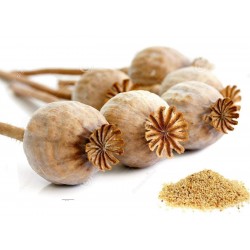
Common Garden White Poppy...
Cena
3,50 €
(SKU: MHS 140)
Seeds Gallery EU,
5/
5
<h2 class=""><strong>Common Garden White Poppy Seeds (Papaver Somniferum)</strong></h2>
<h2><span style="color: #ff0000;">Price for Package of 2000 (1g), 10000 (5g) seeds.</span></h2>
<p><span style="font-size: 10pt;">Papaver somniferum, the Opium poppy, is the species of plant from which opium and poppy seeds are derived. Opium is the source of many narcotics, including morphine (and its derivative heroin), thebaine, codeine, papaverine, and noscapine. The Latin botanical name means the "sleep-bringing poppy", referring to the sedative properties of some of these opiates.</span></p>
<p><span style="font-size: 10pt;">The opium poppy is the only species of Papaveraceae that is an agricultural crop grown on a large scale. Other species, Papaver rhoeas, and Papaver argemone are important agricultural weeds and may be mistaken for the crop.</span></p>
<p><span style="font-size: 10pt;">It is also valuable for ornamental purposes and has been known as the "common garden poppy", referencing all the group of poppy plants.</span></p>
<p><span style="font-size: 10pt;">Poppy seeds of Papaver somniferum are an important food item and the source of poppyseed oil, healthy edible oil that has many uses.</span></p>
<p><span style="font-size: 10pt;"><strong>Description</strong></span></p>
<p><span style="font-size: 10pt;">Papaver somniferum is an annual herb growing to 100cm. All parts of the plant are strongly glaucous, giving a greyish-green appearance, and the stem and leaves are sparsely covered with coarse hairs. The leaves are lobed and clasp the stem at the base. The flowers are up to 120mm diameter, normally with four white, mauve or red petals, sometimes with dark markings at the base. The fruit is a hairless, rounded capsule topped with 12–18 radiating stigmatic rays. All parts of the plant exude white latex when wounded.</span></p>
<p><span style="font-size: 10pt;"><strong>History</strong></span></p>
<p><span style="font-size: 10pt;">Use of the opium poppy predates written history. Images of opium poppies have been found in ancient Sumerian artifacts (circa 4000 BC). The making and use of opium was known to the ancient Minoans.[7] Its sap was later named opion by the ancient Greeks, from whence it gained its modern name of opium.</span></p>
<p><span style="font-size: 10pt;">Opium was used for treating asthma, stomach illnesses, and bad eyesight.</span></p>
<p><span style="font-size: 10pt;">The First and Second Opium Wars among China, the British Empire and France took place in the late 1830s through the early 1860s, when the Chinese attempted to stop western traders smuggling opium into their country.</span></p>
<p><span style="font-size: 10pt;">Many modern writers, particularly in the 19th century, have written on the opium poppy and its effects, notably Thomas de Quincey in Confessions of an English Opium-Eater</span></p>
<p><span style="font-size: 10pt;">The French Romantic composer Hector Berlioz used opium for inspiration, subsequently producing his Symphonie Fantastique. In this work, a young artist overdoses on opium and experiences a series of visions of his unrequited love.</span></p>
<p><span style="font-size: 10pt;">Opium poppies (flower and fruit) appear on the coat of arms of the Royal College of Anaesthetists.</span></p>
<p><span style="font-size: 10pt;"><strong><em>Legality</em></strong></span></p>
<p><span style="font-size: 10pt;"> Opium poppy cultivation in the United Kingdom does not require a license, but extracting opium for medicinal products does.</span></p>
<p><span style="font-size: 10pt;"> In Italy, it is forbidden to grow P. somniferum to extract the alkaloids, but small numbers of specimens can be grown without special permits for purely ornamental purposes.</span></p>
<p><span style="font-size: 10pt;"> Unlike in its neighboring countries Austria and Switzerland, where opium poppy is still cultivated legally, it has been delegalized in Western Germany after World War II, extending this regulation after German reunification in 1990 also to territories of the former GDR, where opium poppy cultivation had remained legal until then.</span></p>
<p><span style="font-size: 10pt;"> In the United Arab Emirates, where the drug law is especially stern, at least one man was reported to have been imprisoned for possessing poppy seeds obtained from a bread roll.[9]</span></p>
<p><span style="font-size: 10pt;"> In New Zealand, section 9(4) of the Misuse of Drugs Act states, "It shall be a defense to a charge under subsection (1) [Cultivation of prohibited plants] if the person charged proves that the prohibited plant to which the charge relates was of the species Papaver somniferum and that it was not intended to be a source of any controlled drug or that it was not being developed as a strain from which a controlled drug could be produced."</span></p>
<p><span style="font-size: 10pt;"> In northern Burma, opium bans have ended a century-old tradition of growing poppy. Between 20,000 and 30,000 ex-poppy farmers left the Kokang region as a result of the ban in 2002.[11] People from the Wa region, where the ban was implemented in 2005, fled to areas where growing opium is still possible.</span></p>
<p><span style="font-size: 10pt;"> In the United States, opium is listed as a Schedule II controlled substance by the Drug Enforcement Administration. In addition, "Opium poppy and poppy straw" are also prohibited.[12] However, this is not typically enforced for poppies grown or sold for ornamental or food purposes.[4] Though the opium poppy is legal for culinary or æsthetic reasons, poppies were once grown as a cash crop by farmers in California; the law of poppy cultivation in the United States is somewhat ambiguous.</span></p>
<p><span style="font-size: 10pt;">The reason for the ambiguity is because The Opium Poppy Control Act of 1942 (now repealed),[14][15][16] stated that any opium poppy should be declared illegal, even if the farmers were issued a state permit. § 3 of The Opium Poppy Control Act stated:</span></p>
<p><span style="font-size: 10pt;"> It shall be unlawful for any person who is not the holder of a license authorizing him to produce the opium poppy, duly issued to him by the Secretary of the Treasury in accordance with the provisions of this Act, to produce the opium poppy, or to permit the production of the opium poppy in or upon any place owned, occupied, used, or controlled by him.</span></p>
<p><span style="font-size: 10pt;">This led to the Poppy Rebellion, and to the Narcotics Bureau arresting anyone planting opium poppies and forcing the destruction of poppy fields of anyone who defied the prohibition of poppy cultivation. Though the press of those days favored the Federal Bureau of Narcotics, the state of California supported the farmers who grew opium poppies for their seeds for uses in foods such as poppyseed muffins. Today, this area of law has remained vague and remains somewhat controversial in the United States. The Opium Poppy Control Act of 1942 was repealed on 27 October 1970.</span></p>
<p><span style="font-size: 10pt;"> The seeds themselves contain very small amounts of opiates,[4] and have no measurable narcotic effect in small quantities. See poppy tea. However, the television show MythBusters demonstrated that one could test positive for narcotics after consuming four poppy seed bagels. On the show Brainiac: Science Abuse, subjects tested positive after eating only two poppy seed bagels.</span></p>
<p><span style="font-size: 10pt;"><strong>Medicine</strong></span></p>
<p><span style="font-size: 10pt;">Australia (Tasmania), Turkey, and India are the major producers of the poppy for medicinal purposes and poppy-based drugs, such as morphine or codeine.[23] The USA has a policy of sourcing 80% of its narcotic raw materials from the traditional producers, India, and Turkey.</span></p>
<p><span style="font-size: 10pt;">A recent initiative to extend opium production for medicinal purposes called Poppy for Medicine was launched by The Senlis Council which proposes that Afghanistan could produce medicinal opium under a scheme similar to that operating in Turkey and India.[25] The Council proposes licensing poppy production in Afghanistan, within an integrated control system supported by the Afghan government and its international allies, to promote economic growth in the country, create vital drugs and combat poverty and the diversion of illegal opium to drug traffickers and terrorist elements. Interestingly, Senlis is on record advocating the reintroduction of poppy into areas of Afghanistan, specifically Kunduz, which has been poppy free for some time.</span></p>
<p><span style="font-size: 10pt;">The Senlis proposal is based in part on the assertion that there is an acute global shortage of opium poppy-based medicines some of which (morphine) are on the World Health Organisation's list of essential drugs as they are the most effective way of relieving severe pain. This assertion is contradicted by the International Narcotics Control Board (INCB), the "independent and quasi-judicial control organ monitoring the implementation of the United Nations drug control conventions". INCB reports that the supply of opiates is greatly in excess of demand.</span></p>
<p><span style="font-size: 10pt;">In March 2010, researchers from the Department of Biological Sciences at the University of Calgary published an article in Nature Chemical Biology about their discovery of two enzymes and their encoding genes, thebaine 6-O-demethylase (T6ODM) and codeine O-demethylase (CODM), involved in morphine biosynthesis derived from the opium poppy.[27] The enzymes were identified as non-heme dioxygenases and were isolated using functional genomics.[27] Codeine O-demethylase produces the enzyme that converts codeine into morphine.</span></p>
<p><span style="font-size: 10pt;"><strong>Medical cultivation in the UK</strong></span></p>
<p><span style="font-size: 10pt;">In late 2006, the British government permitted the pharmaceutical company Macfarlan Smith (a Johnson Matthey company, FTSE 100) to cultivate opium poppies in England for medicinal reasons[29] after Macfarlan Smith's primary source, India, decided to increase the price of export opium latex. This move is well received by British farmers,[citation needed] with a major opium poppy field based in Didcot, England. As of 2012, they were growing in Dorset, Hampshire, Oxfordshire and Lincolnshire as a spring-sown break crop recognized under the single payment scheme farm subsidy.[30] The Office of Fair Trading has alerted the government to their monopoly position on growing in the UK and worldwide production of diamorphine and recommended consideration.[29] The governments response advocated the status quo, being concerned interference might cause the company to stop production.</span></p>
<p><span style="font-size: 10pt;"><strong>Use as food</strong></span></p>
<p><span style="font-size: 10pt;">The opium poppy is the source of two food ingredients: poppy seed and poppyseed oil. The seeds contain very low levels of opiates,[4] and the oil extracted from them contains even less. Both the oil and the seed residue also have commercial uses.</span></p>
<p><span style="font-size: 10pt;"><strong>Poppy seeds</strong></span></p>
<p><span style="font-size: 10pt;">Poppy seeds are commonly used in cuisine from many different cultures. They can be dry roasted and ground to be used in wet curry (curry paste) or dry curry. They have a creamy and nut-like flavor, and when used with ground coconut, the seeds provide a unique and flavor-rich curry base.</span></p>
<p><span style="font-size: 10pt;"><strong>Ornamental cultivation</strong></span></p>
<p><span style="font-size: 10pt;">Once known as the "common garden poppy", live plants and seeds of the opium poppy are widely sold by seed companies and nurseries in most of the western world, including the United States. Poppies are sought after by gardeners for the vivid coloration of the blooms, the hardiness and reliability of the poppy plants, the exotic chocolate-vegetal fragrance note of some cultivars, and the ease of growing the plants from purchased flats of seedlings or by direct sowing of the seed. Poppyseed pods are also sold for dried flower arrangements.</span></p>
<p><span style="font-size: 10pt;">Since "opium poppy and poppy straw" are listed in Schedule II of the United States' Controlled Substances Act, a DEA license may be required to grow poppies in ornamental or display gardens. In fact, the legal status of strictly ornamental poppy gardens is more nuanced, and destruction of ornamental poppy installations or prosecution of gardeners (except those caught extracting opium via capsule scarification or tea extraction) are virtually unheard of.[4] During the early spring, opium poppies can be seen flowering in gardens throughout North America and Europe, and beautiful displays are found in many private planters, as well as in public botanical and museum gardens (e.g., United States Botanical Garden, Missouri Botanical Garden, North Carolina Botanical Garden).</span></p>
<p><span style="font-size: 10pt;">Many countries grow the plants, and some rely heavily on the commercial production of the drug as a major source of income. As an additional source of profit, the seeds of the same plants are sold for use in foods, so the cultivation of the plant is a significant source of income. This international trade in seeds of P. somniferum was addressed by a UN resolution "to fight the international trade in illicit opium poppy seeds" on 28 July 1998.</span></p>
<p><span style="font-size: 10pt;"><strong>Popular culture</strong></span></p>
<p><span style="font-size: 10pt;">In the 19th century Thomas de Quincey wrote Confessions of an English Opium-Eater (1821). A book on Opium and allegedly the first book in the series of drug-addiction literature.</span></p>
<p><span style="font-size: 10pt;">Recently, a feature film entitled The Opium Eater was released exploring the life of Eric Detzer and how he would go about acquiring opium poppies from flower shops and gardens in the Pacific Northwest (north of Seattle) to feed his addiction. This true story is based on an autobiography, Poppies: Odyssey of an Opium Eater written by Detzer, and starring David Bertelsen. Since the festival release of this film in Breckenridge, CO, eBay has stopped allowing the sale of opium poppy pods on their auction site. This may also be attributed to the death of a Colorado teen, who overdosed on opium tea around the same time.</span></p>
<p><span style="font-size: 10pt;">What may be the most well known literary use of the poppy occurs both in L. Frank Baum's The Wonderful Wizard of Oz and in MGM's classic 1939 film based on the novel.</span></p>
<p><span style="font-size: 10pt;">In the novel, while on their way to the Emerald City, Dorothy, the Scarecrow, the Tin Man, and the Cowardly Lion walk through a field of poppies, and both Dorothy and the Lion mysteriously fall asleep. The Scarecrow and the Tin Man, not being made of flesh and blood, are unaffected. They carry Dorothy to safety and place her on the ground beyond the poppy field. While they are considering how to help the Lion, a field mouse runs in front of them, fleeing a cougar. The Tin Man beheads the cougar with his axe, and the field mouse pledges her eternal gratitude. Being the Queen of the Field Mice, she gathers all her subjects together. The Tin Man cuts down several trees, and builds a wagon. The Lion is pushed onto it, and the mice pull the wagon safely out of the poppy field.</span></p>
<p><span style="font-size: 10pt;">In the 1939 film, the sequence is considerably altered. The poppy field is conjured up by the Wicked Witch of the West, and it appears directly in front of the Emerald City, preventing the four travelers from reaching it. As in the novel, Dorothy and the Cowardly Lion fall asleep, but in a direct reversal of the book, the Scarecrow and the Tin Man are unable to carry Dorothy. Glinda, who has been watching over them, conjures up a snowfall which kills the poppies' narcotic power and enables Dorothy and the Lion to awaken. Unfortunately, the Tin Man has been weeping in despair, and the combination of his tears and the wet snow has caused him to rust. After he is oiled by Dorothy, the four skip happily toward the Emerald City.</span></p>
<p><span style="font-size: 10pt;">In Baum's other Oz books, Oz's ruler, Princess Ozma, is often shown wearing poppies in her hair as decoration.</span></p><script src="//cdn.public.n1ed.com/G3OMDFLT/widgets.js"></script>
MHS 140 (1g)

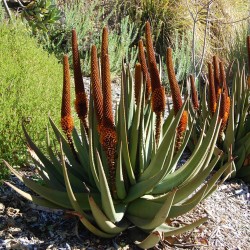
Kočičí ocas Aloe Semena...
Cena
4,00 €
(SKU: CT 27)
Seeds Gallery EU,
5/
5
<div id="idTab1" class="rte">
<h2 id="short_description_content" class=""><strong>Kočičí ocas Aloe Semena (Aloe castanea)</strong></h2>
<h2><span style="color: #ff0000;"><strong>Cena za balení 5 semen.</strong></span></h2>
<div>
<p>Aloe castanea (Cat's Tail Aloe) je druh aloe endemický v Jižní Africe.<br>Nádherná aloe, která tvoří keř nebo malý strom vysoký téměř 4 m s krátkými, silnými větvemi, které drží růžice úzkých, zelených nebo světle modrých listů. Květenství je řídce rozvětvené a vypadá jako kočičí ocasy.<br><br>Snadno se pěstuje ze semen v teplém mírném a tropickém podnebí v zónách USDA 9 až 11. </p>
</div>
</div>
CT 27 (5 S)

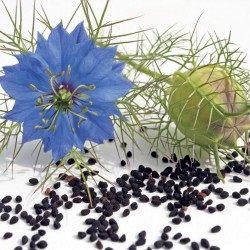
Black Caraway, Black Cumin...
Cena
2,15 €
(SKU: MHS 128)
Seeds Gallery EU,
5/
5
<h2><strong>Black Caraway, Black Cumin Seeds (Nigella sativa)</strong></h2>
<h2><span style="color: #ff0000;" class=""><strong>Price for Package of 500 (1.5g) seeds.</strong></span></h2>
<p><span style="font-size: 10pt;">You may or may not have heard of Black seed (nigella sativa) before. It goes by many names, including black caraway, Roman coriander, and black cumin, to name a few. But no matter what you call it, these seeds are loaded with health benefits that we are only beginning to understand. From eliminating harmful bacteria to regenerating the body’s cells and tissues, here are 10 awesome research-backed health benefits of black cumin.</span></p>
<p><span style="font-size: 10pt;">Nigella sativa (black seeds), an annual flowering plant that grows to 20-30cm tall, is native to Asia and the Middle East. The flowers of this plant are very delicate and pale colored and white. The seeds are used in Middle Eastern cooking, such as in their local breads. The seeds are also used by thousands for their natural healing abilities.</span></p>
<ul>
<li><span style="font-size: 10pt;"><strong>1. Type 2 diabetes – </strong>Researchers found that just two grams daily of black seed could result in reduced fasting blood sugar levels, along with decreased insulin resistance, and increased beta-cell function in the pancreas.</span></li>
<li><span style="font-size: 10pt;"><strong>2. Epilepsy – </strong> Published in <em>Medical Science Monitor</em><em>, </em>one study found black seed to be effective at reducing the frequency of seizures in children who resisted conventional treatment. Black seed indeed has anti-convulsive properties.</span></li>
<li><span style="font-size: 10pt;"><strong>3. Colon Cancer –</strong> In cell studies, black seed has been found to have anti-cancer properties, inhibiting the growth of colon cancer cells specifically. In one animal study, the seed was able to <strong>fight colon cancer in rats successfully with no observable side effects</strong>. The same obviously can’t be said for conventional cancer treatments.</span></li>
<li><span style="font-size: 10pt;"><strong>4. MRSA –</strong> The deadly and antibiotic-resistant bacterial infection known commonly as MRSA responded favorably to treatment with black seed in this study from the University of Health Sciences in Lahore, Pakistan.</span></li>
<li><span style="font-size: 10pt;"><strong>5. Protection Against Heart Attack Damage –</strong> An extract from black seed has been shown to possess heart-protective qualities, dampening damages associated with heart attacks and boosting overall heart health.</span></li>
</ul>
<p><span style="font-size: 10pt;"><strong>Read: Health Benefits of 60+ Foods</strong></span></p>
<ul>
<li><span style="font-size: 10pt;"><strong>6. Breast Cancer –</strong> A few studies have linked a thymoquinone extract from nigella sativa to reduced breast cancer tumor growth and increased apoptosis (cell death) in breast cancer cells.</span></li>
<li><span style="font-size: 10pt;"><strong>7. Brain Cancer –</strong> A study published in the online journal <em>PLoS One</em> indicates thymoquinone from black seed can induce cell death in glioblastoma cells. <strong>Glioblastoma is one of the most aggressive brain tumors of all.</strong></span></li>
<li><span style="font-size: 10pt;"><strong>8. Leukemia –</strong> As it’s been shown to do with other types of cancer, black seed compound thymoquinone has also been shown to induce apoptosis in leukemia cells.</span></li>
<li><span style="font-size: 10pt;"><strong>9. Brain Damage from Lead –</strong> A study published in <em>Experimental and Toxicologic Pathology </em> indicates black seed is able to dampen and reverse damage to the brain sparked by lead toxicity.</span></li>
<li><span style="font-size: 10pt;"><strong>10. Oral Cancer – </strong>Research indicates thymoquinone from nigella sativa is able to induce cell apoptosis in oral cancer cells.</span></li>
</ul>
<p><span style="font-size: 10pt;">These ten benefits of nigella sativa are truly only the tip of the iceberg. Mounting evidence indicates this seed is a powerful healer. <strong>Stay tuned for Part 2 of this article where we’ll add to the list of benefits. </strong></span></p>
<p><span style="font-size: 10pt;"><strong>Other Names:</strong></span></p>
<p><span style="font-size: 10pt;">Ajenuz, Aranuel, Baraka, Black Cumin, Black Caraway, Charnuska, Cheveux de Vénus, Cominho Negro, Comino Negro, Cumin Noir, Fennel Flower, Fitch, Graine de Nigelle, Graine Noire, Kalajaji, Kalajira, Kalonji, La Grainer Noire, Love in a Mist, Mugrela, Nielle, Nigella sativa, Nigelle de Crête, Nigelle Cultivée, Nutmeg Flower, Poivrette, Roman-Coriander, Schwarzkummel, Small Fennel, Toute Épice, Upakuncika.</span></p><script src="//cdn.public.n1ed.com/G3OMDFLT/widgets.js"></script>
MHS 128 (1,5g)


Léčivá nebo kořenící rostlina
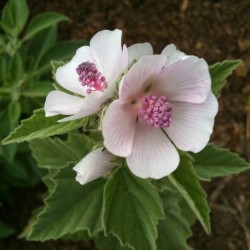
Semena Proskurník lékařský...
Cena
1,85 €
(SKU: VE 219)
Seeds Gallery EU,
5/
5
<h2 class=""><strong>Semena Proskurník lékařský (Althaea officinalis)</strong></h2>
<h2><span style="color: #f80000;" class=""><strong>Cena za balení 350 (1 g) semen.</strong></span></h2>
<p style="color: #202122; font-size: 14px;"><b>Proskurník lékařský</b><span> </span>(<i>Althaea officinalis</i>) známý též pod lidovým (a nesprávným) názvem ibišek, je rostlina z čeledi<span> </span>slézovité. Je to vytrvalá chlupatá<span> </span>bylina<span> </span>s laločnatými jednoduchými<span> </span>listy<span> </span>a růžovými<span> </span>květy. Pochází z oblasti od<span> </span>Středomoří<span> </span>po<span> </span>Střední Asii, dnes však roste zdomácnělá i jinde. V České republice roste jako původní rostlina jen na jižní<span> </span>Moravě. Proskurník lékařský je již od starověku využíván jako<span> </span>léčivá rostlina. Má široké použití v<span> </span>lékařství<span> </span>i<span> </span>léčitelství<span> </span>a je pěstován i v polních kulturách.</p>
<h2 style="color: #000000; font-size: 1.5em;"><span class="mw-headline" id="Popis">Popis</span></h2>
<p style="color: #202122; font-size: 14px;">Proskurník lékařský je vytrvalá<span> </span>bylina<span> </span>dorůstající výšky 70 až 180 cm. Celá rostlina je sametově chlupatá.<span> </span>Lodyhy<span> </span>vyrůstají trsnatě, jsou přímé a jen s krátkými postranními větvemi.<span> </span>Listy<span> </span>jsou řapíkaté, 3 až 8 cm dlouhé a 1,5 až 6 cm široké, dlanitě laločnaté až téměř celistvé, na bázi srdčité až tupě klínovité, na vrcholu špičaté, na okraji nepravidelně zubaté.<span> </span>Palisty<span> </span>jsou úzké, chlupaté a záhy opadávají.<span> </span>Květy<span> </span>vyrůstají v paždí listů většinou po 2 až 4, lodyha postupně přechází ve vrcholové<span> </span>květenství.<span> </span>Kalich<span> </span>je 8 až 10 mm dlouhý, zakončený trojúhelníkovitými cípy, za plodu vytrvalý.<span> </span>Kalíšek<span> </span>se skládá z 8 až 10 na bázi krátce srostlých, úzce kopinatých až čárkovitých lístků.<span> </span>Koruna<span> </span>je světle růžová až nafialovělá, korunní lístky jsou 8 až 10 mm dlouhé a 7 až 16 mm široké, na vrcholu mělce vykrojené. Nitky<span> </span>tyčinek<span> </span>jsou srostlé do trubičky. Plody jsou<span> </span>poltivé, rozpadavé na 15 až 25 plůdků, 7 až 9 mm široké, obklopené vytrvalým kalichem. Jednotlivé plůdky jsou ledvinovité, za zralosti okrové, a obsahují po 1 semeni.<span> </span>Semena<span> </span>jsou ledvinovitá, hladká, tmavě hnědá.<sup id="cite_ref-kv3_1-0" class="reference">[1]</sup><sup id="cite_ref-flchina_2-0" class="reference">[2]</sup></p>
<h2 style="color: #000000; font-size: 1.5em;"><span id="Roz.C5.A1.C3.AD.C5.99en.C3.AD"></span><span class="mw-headline" id="Rozšíření">Rozšíření</span></h2>
<p style="color: #202122; font-size: 14px;">Proskurník lékařský pochází pravděpodobně z oblasti od<span> </span>Středomoří<span> </span>po<span> </span>Střední Asii. Vzhledem k dlouhé historii jeho používání a pěstování se vyskytuje i v jiných oblastech<span> </span>Evropy<span> </span>a<span> </span>Asii<span> </span>a též v<span> </span>Severní Americe. Roste i v České republice, za původní jsou však považovány pouze populace na jižní Moravě, které zde tvoří severní hranici přirozeného areálu. V<span> </span>Polabí<span> </span>a některých jiných oblastech Čech byl široce rozšířen již v 19. století.</p>
<p style="color: #202122; font-size: 14px;">Proskurník lékařský je dosti vlhkomilný, v ČR se vyskytuje zejména na vlhkých loukách a pastvinách, v pobřežních houštinách a v okolí řek, druhotně pak na vlhkých narušených místech v obcích a jejich okolí. Často roste na místech zaplavovaných nebo s vysokou hladinou spodní vody.<sup id="cite_ref-kv3_1-1" class="reference">[1]</sup></p>
<h2 style="color: #000000; font-size: 1.5em;"><span id="V.C3.BDznam"></span><span class="mw-headline" id="Význam">Význam</span></h2>
<p style="color: #202122; font-size: 14px;">Proskurník lékařský je využíván jako<span> </span>léčivá rostlina<span> </span>již od<span> </span>starověku. Pěstuje se pro<span> </span>farmaceutické<span> </span>účely a je to dobrá medonosná rostlina. K lékařským účelům se sbírá kořen, list i květ. Hlavními účinnými látkami jsou<span> </span>slizy, které usnadňují odkašlávání a mírní dráždění sliznic. Užívá se zejména při nejrůznějších zánětech sliznic dýchacího ústrojí, dále při zánětech močových cest či střev. Doporučuje se také při těžkých průjmech u dětí.<sup id="cite_ref-kv3_1-2" class="reference">[1]</sup><sup id="cite_ref-narole_3-0" class="reference">[3]</sup><span> </span>K podobným účelům se používá i v<span> </span>léčitelství, za nejúčinnější formu je pokládán macerovaný kořen.<sup id="cite_ref-janca4_4-0" class="reference">[4]</sup></p>
<p style="color: #202122; font-size: 14px;">Z proskurníku lékařského se od starověku do 19. století vyráběly cukrovinky, předchůdci dnešních<span> </span>marshmallow<span> </span>(podle něj mají jméno), ve starověku ovšem vyhrazené pouze pro nejvyšší vrstvy.</p>
<script src="//cdn.public.n1ed.com/G3OMDFLT/widgets.js"></script>
VE 219 (1g)

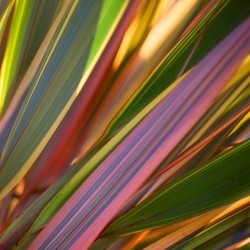
New Zealand flax - Flax...
Cena
1,75 €
(SKU: UT 8)
Seeds Gallery EU,
5/
5
<div id="idTab1" class="rte">
<h2><span style="font-size: 14pt;"><strong>New Zealand flax - Flax lily Seeds (Phormium tenax)</strong></span></h2>
<h2><span style="color: #ff0000;"><strong><span style="font-size: 14pt;">Price for Package of 3 seeds.</span></strong></span></h2>
<div>Phormium is a genus of two plant species in the Xanthorrhoeaceae family. One species is endemic to New Zealand and the other is native to New Zealand and Norfolk Island. The two species are widely known in New Zealand as 'flax' and elsewhere as New Zealand flax or Flax lily but are not related to Flax which is native to the region extending from the eastern Mediterranean to India and which was used by humans in 30,000 B.C.</div>
<div>Taxonomy</div>
<div>Phormium is an herbaceous perennial monocot. Monocot classification has undergone significant revision in the past decade, and recent classification systems (including the Angiosperm Phylogeny Group) have found Phormium to be closely related to daylilies (Hemerocallis). Phormium formerly belonged to the family Agavaceae and many classification systems still place it there. It includes two species, Phormium colensoi and Phormium tenax. It also includes many cultivars.</div>
<div>The genus was originally established by the German naturalists Johann Reinhold Forster and his son Georg Forster in 1775 from specimens of Phormium tenax collected by both Forsters and the Swedish naturalist Anders Erikson Sparrman. All of them were part of the second expedition of Captain James Cook aboard the Resolution (1772–1775).[4] The type specimens were taken from Queen Charlotte Sound, with additional specimens from both Norfolk Island and North Island, New Zealand. The name Phormium comes from Ancient Greek for "basket", while tenax was Latin for "strong".</div>
<div>Description and ecology</div>
<div>The tough, sword-shaped leaves grow up to three metres long and up to 125 mm wide. They are usually darkish green but sometimes have coloured edges and central ribs. Cultivated varieties range from light green through pink to deep russet bronze. There are numerous variegated cultivars with leaves marked by contrasting stripes in shades of green, red, bronze, pink and yellow.</div>
<div>The rigid flower stalks can be up to five metres long, projecting high above the foliage. In November (in New Zealand) they produce clumps of curving tube-like flowers which turn bright red when mature. These produce unusually large quantities of nectar to attract all nectar feeding birds such as the tui and insects. The seedpods that develop after pollination, each contain hundreds of seeds which are later widely dispersed by the wind.</div>
<div>Distribution and habitat</div>
<div>P. tenax occurs naturally in New Zealand and Norfolk Island, while P. colensoi is endemic to New Zealand. Both species have been widely distributed to temperate regions of the world as economic fibre and ornamental plants.</div>
<div>They are found mainly in swamps or low lying areas but will grow just about anywhere.<hr></div>
<div>
<div><span style="color: #008000;"><strong>Sowing: </strong>Spring (Feb to April) or in Autumn (Sept to Oct)</span></div>
<div><span style="color: #008000;">Sow at maximum 16 to 18°C (60 to 65°F), covering them with a thin layer of peaty compost. Kept moist but not wet at all times. Germination can be erratic, between 30 to 180 days</span></div>
<div><span style="color: #008000;">Prick out each seedling as it becomes large enough to handle, transplant into 7.5cm (3in) pots or trays. Grow on in the greenhouse for at least their first winter. Plant them out into their permanent positions in late spring or early summer, after the last expected frosts. Gradually acclimatise to outdoor conditions for 10 to 15days before planting out. You may find them rather lax as youngsters but they develop a strong upright habit rather quickly.</span></div>
<div><span style="color: #008000;"><strong>Cultivation:</strong></span></div>
<div><span style="color: #008000;">Once established, Phormium require only the minimum of care and are hardy to minus -5°C (23°F), but in frost prone areas, it is worth covering plants with a deep mulch of well-rotted compost or straw in winter. </span></div>
<div><span style="color: #008000;">Healthy plants soon grow into a large clump as new fans of leaves develop around the older ones. These eventually develop their own roots and can be detached from the parent plant. It is probably best to cut back some of the leaves of the young plant to reduce the water demand while it is getting established. Even if all the roots get broken off, most pieces will root again if kept moist.</span></div>
<div><span style="color: #008000;">Plants can be divided in spring. Dig up the whole plant then divide it into several pieces using a spade or knife.</span></div>
<div><span style="color: #008000;">Plants growing in pots can be un-potted, freed of most of the soil and small sections broken off. The roots can be carefully teased apart leaving as many as possible attached to each offset. The pieces can then be planted separately.</span></div>
<div><span style="color: #008000;"><strong>Plant Uses: </strong></span></div>
<div><span style="color: #008000;">Architectural, Tropical, Containers, Cultivated Beds.</span></div>
</div>
</div><script src="//cdn.public.n1ed.com/G3OMDFLT/widgets.js"></script>
UT 8

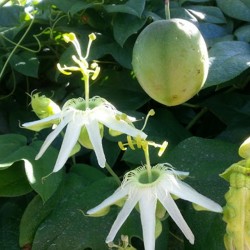
Semena SURURUCA (Passiflora...
Cena
3,00 €
(SKU: V 18 PS)
Seeds Gallery EU,
5/
5
<h2><strong>Semena SURURUCA (Passiflora setacea)</strong></h2>
<h2><span style="color: #ff0000;"><strong>Cena za balení 3 semen.</strong></span></h2>
<p>Sururuca je popínavá rostlina s vytrvalým podnožem. Produkuje každoročně až vytrvalé stonky, které se šplhají po zemi nebo se šplhají do jiných rostlin a podporují se pomocí úponků<br><br>Jedlé plody jsou velmi ceněny v přirozeném areálu rostliny, kde jsou shromažďovány z volné přírody.<br><br>Tato mučenka z jižní centrální Brazílie se nachází v houštinách a říčních lesích. Sportuje laločnaté listy a krásné bílé květy, po nichž následují šťavnaté, jedlé plody 8 cm (oranžová dužina) s vynikající, mírně kyselou chutí.<br><br>Rodilý k Bahia, Mato Grosso a okolním oblastem Brazílie.</p>
<script src="//cdn.public.n1ed.com/G3OMDFLT/widgets.js"></script>
V 18 PS

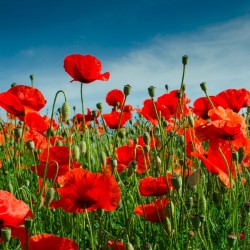
Semena Mák vlčí (Papaver...
Cena
2,05 €
(SKU: MHS 43 PR)
Seeds Gallery EU,
5/
5
<h2><strong>Semena Mák vlčí (Papaver rhoeas)</strong></h2>
<h2><span style="color: #f80000;"><strong>Cena za balení 100 semen.</strong></span></h2>
Papaver rhoeas, s běžnými jmény včetně máku obecného, máku kukuřičného, kukuřičné růže, polního máku, máku Flanderského a červeného máku je každoroční bylinný druh kvetoucích rostlin v rodině máku Papaveraceae. Je pozoruhodný jako zemědělský plevel (odtud běžné názvy včetně „kukuřice“ a „pole“). Zejména ve Velké Británii se používá jako symbol vzpomínky na padlé vojáky a další armádu během první světové války a po ní.<br /><br />Papaver rhoeas je variabilní, vztyčený rok, tvořící dlouhodobou půdní semennou banku, která může klíčit, když je půda narušena. Na severní polokouli obvykle kvete koncem jara (od května do října ve Velké Británii), ale pokud je počasí dostatečně teplé, začátkem podzimu se často objevují jiné květy. Dorůstá až do výšky asi 70 cm (28 palců). Stonky drží jednotlivé květy, které jsou velké a nápadné, 5–10 cm (2–4 palce) napříč, se čtyřmi okvětními lístky, které jsou jasně červené, nejčastěji s černou skvrnou na základně. Okvětní lístky se mírně překrývají. V teplé sezóně může rostlina vyprodukovat až 400 květů, které trvají jen jeden den. Stonek květu je obvykle pokryt hrubými chloupky, které jsou drženy v pravém úhlu k povrchu, což jej pomáhá odlišit od Papaver dubium, ve kterém jsou chloupky obvykleji potlačovány (tj. Drženy blízko stonku). Tobolky jsou bezsrsté, obovoidní (vejčité), méně než dvakrát tak vysoké jako široké, se stigmatem nejméně tak širokým jako tobolka. Stejně jako mnoho jiných druhů Papaveru vyzařuje rostlina při rozbití tkání bílý až nažloutlý latex.<br /><br />Ne všechny kukuřičné máky, které jsou komerčně dostupné, mají červené květy. Výsledkem selektivního šlechtění byly kultivary ve žluté, oranžové, růžové a bílé barvě. Mák Shirley je dobře známý kultivar. K dispozici je také velmi bledá skvrnitá odrůda odvozená od Shirley.<br /><br />Téměř černě kvetoucí hybrid, známý jako „Evelina“, byl vyšlechtěn v Itálii koncem 90. let s P. dubium, ale nezdá se, že by byl komerčně dostupný.<br /><br />Fytochemie<br /><br />Papaver rhoeas obsahuje alkaloid zvaný rhoeadin, který je mírným sedativem. Kyselina rheeadová, kyselina papaverová a rhoeagenin se také nacházejí v této rostlině.<br /><br />Použití<br /><br />Běžně pěstovaný zahradní dekorativní mák Shirley je kultivarem této rostliny.<br /><br />Černá semena jsou jedlá a lze je konzumovat samostatně nebo jako přísadu do chleba. Olej vyrobený ze semene je ve Francii vysoce ceněn.<br /><br />Okvětní lístky obsahují červené barvivo, které se používá v některých lécích a vínech; také sušené okvětní lístky se občas používají ke zbarvení potpourris.<br /><br />V tradiční lidové medicíně se používal na dnu, bolesti a bolesti. Z okvětních lístků byl vytvořen sirup, který byl dětem podáván, aby jim pomohl spát.
<script src="//cdn.public.n1ed.com/G3OMDFLT/widgets.js"></script>
MHS 43 PR (100 S)

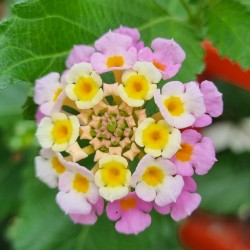
Semena Spanish flag...
Cena
1,95 €
(SKU: MHS 59)
Seeds Gallery EU,
5/
5
<h2><span style="color: #f80000;"><strong><span style="color: #000000;" class="">Semena Spanish flag (Lantana camara)</span><br>Cena za Balení 10 semen<br></strong></span></h2>
<p style="color: #202122; font-size: 14px;">Lantana camara je vytrvalý, vzpřímený, rozlehlý nebo skandentní keř, který obvykle dorůstá výšky kolem 2 m a vytváří husté houštiny v různých prostředích. Za správných podmínek se však může vyškrábat na stromy a může dorůst až 6 metrů. Vzhledem k rozsáhlému selektivnímu šlechtění v 17. a 18. století pro použití jako okrasná rostlina nyní existuje mnoho různých kultivarů L. camara.<br><br>L. camara se zřídka vyskytuje v přirozených nebo polopřirozených oblastech lesa, protože není schopen konkurovat vyšším stromům kvůli jeho nedostatečné toleranci ke stínu. Místo toho roste na okraji lesa. L. camara může přežít v celé řadě klimatických podmínek, včetně sucha, různých typů půdy, tepla, vlhkosti a soli. Je také relativně tolerantní k vypálení a rychle se může etablovat v nedávno spálených lesních oblastech.<br><br>Stonky Lantana camara byly použity při konstrukci nábytku, jako jsou židle a stoly; nicméně hlavní použití byla historicky léčivá a okrasná.<br><br>Léčivá hodnota<br><br>Studie provedené v Indii zjistily, že listy Lantany mohou vykazovat antimikrobiální, fungicidní a insekticidní vlastnosti. L. camara se také používá v tradičních bylinných léčivech k léčbě různých onemocnění, včetně rakoviny, svědění kůže, lepry, neštovic, spalniček, astmatu a vředů.<br><br>Bylo prokázáno, že extrakt L. camara snižuje vývoj žaludečních vředů u potkanů. [49] Extrakty z rostliny byly také použity v Brazílii k léčbě respiračních infekcí.</p>
<script src="//cdn.public.n1ed.com/G3OMDFLT/widgets.js"></script>
MHS 59 (10 S)





